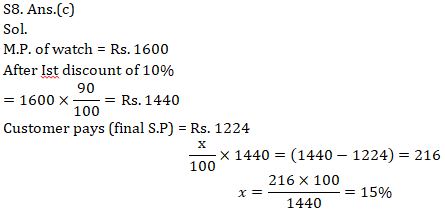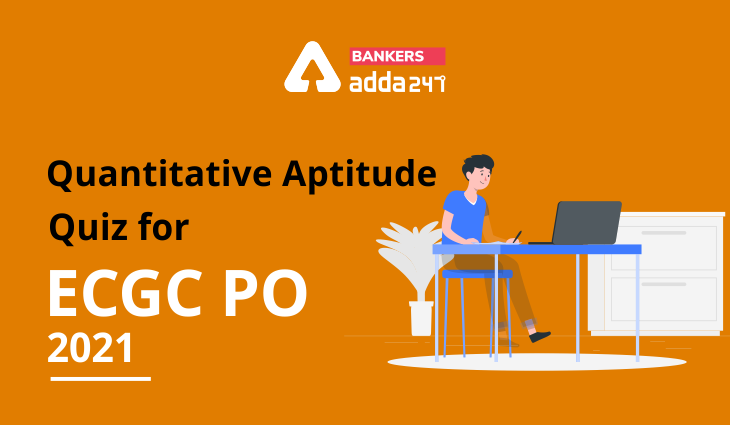Table of Contents
Directions (1-5):- Study the following pie charts carefully and answer the following questions.
Percentage breaks up of number of children in five different villages and break up of children attending school from those villages.

Q1. What is the total number of children not attending school from village Q & S together?
(a) 528
(b) 508
(c) 518
(d) 618
(e) 628
Q2. The number of children attending school from P is approximately what percent of the number of children from that village?
(a) 54%
(b) 56%
(c) 60%
(d) 53%
(e) 58%
Q3. What is the approximate average number of children not attending school from village T, R and S together?
(a) 476
(b) 458
(c) 464
(d) 470
(e) 466
Q4. The number of children not attending school from village R and T is approximately what percent of total number of children from village R and T together?
(a) 43.65%
(b) 42.5%
(c) 48%
(d) 46%
(e) 49.45%
Q5. What is the ratio of total children from village R to the number of children attending school from that village?
(a) 22 : 21
(b) 29 : 28
(c) 29 : 21
(d) 29 : 27
(e) 23 : 21
Q6. The population of a town 3,11,250. The ratio of women and men is 43 : 40. If there are 60% literate among men, the total number of illiterate men in the town is :
(a) 80,000
(b) 60,000
(c) 90,000
(d) 70,000
(e) 68,000
Q7. The price of a refrigerator and a television set are in the ratio 5 : 3. If the refrigerator costs Rs. 5500 more than the television set, then the price of the refrigerator is :
(a) Rs. 27500
(b) Rs 8250
(c) Rs 13750
(d) Rs 16500
(e) Rs 15500
Q8. The marked price of a watch is Rs 1,600. The shopkeeper gives successive discount of 10% and x% to the customer. If the customer pays Rs 1,224 for the watch, the value of x is
(a) 5%
(b) 10%
(c) 15%
(d) 20%
(e) 18%
Q9. A box contains Rs 56 in the form of coins of one rupee, 50 paise and 25 paise. The number of 50 paise coins is double the number of 25 paise coins and four times the number of one-rupee coins. How many 50 paise coins are there in the box?
(a) 52
(b) 64
(c) 32
(d) 16
(e) 18
Q10. A skilled, a half skilled and an unskilled laborer work for 7, 8 and 10 days respectively and they together get Rs 396 for their work. If the ratio of their each day’s work is ![]() , then how much does the skilled labourer get (in rupees)?
, then how much does the skilled labourer get (in rupees)?
(a) 164
(b) 162
(c) 145
(d) 154
(e) 126
Directions (11-15): Study the data carefully & answer the questions.
Table given below shows the no. of bike in different shops & percentage of bike in bad condition.

Note: No. of bike in each shop = No. of bike in good condition + No. of bike in bad condition.
Q11. No. of bike in good condition in shop B & E together is how much more than no. of bike in bad condition in shop A & C together?
(a) 2656
(b) 2646
(c) 2648
(d) 2664
(e) 2668
Q12. No. of bike in bad condition I n shop A is what percentage more than no. of bike in bad condition in shop B?
(a) 110%
(b) 105%
(c) 125%
(d) 115%
(e) 135%
Q13. What is the average of no. of bike in good condition in shop C and E?
(a) 1236
(b) 1216
(c) 1226
(d) 1246
(e) 1256
Q14. Find the ratio of no. of bike in bad condition in shop B & D together to 1/4 th no. of bike in good condition in Shop A?
(a) 146 : 123
(b) 146 : 127
(c) 146 : 129
(d) 149 : 126
(e) 146 : 121

Practice More Questions of Quantitative Aptitude for Competitive Exams:
Quantitative Aptitude for Competitive Exams |
Quantitative Aptitude Quiz For ECGC PO 2021- 20th February |
Quantitative Aptitude Quiz For ECGC PO 2021- 19th February |
ECGC PO Study Plan 2021 |
Solutions








Practice with Crash Course and Online Test Series for ECGC PO 2021:
- ECGC Online Coaching Classes for Probationary Officier 2021
- ECGC PO Mock Tests 2021 – Banking Online Test Series (With Solutions) by Adda247
- ECGC PO 2021 Complete eBooks Kit (English Medium)
Click Here to Register for Bank Exams 2020 Preparation Material




 GA Capsule for SBI Clerk Mains 2025, Dow...
GA Capsule for SBI Clerk Mains 2025, Dow...
 The Hindu Review October 2022: Download ...
The Hindu Review October 2022: Download ...
 Rajasthan Gramin Bank Formed after Merge...
Rajasthan Gramin Bank Formed after Merge...





